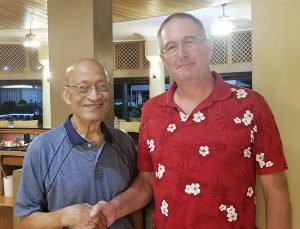Boothe makes fifth trip to childhood ‘playground’

Gary Boothe, left, meets with David “Uncle Dave” M. Sablan who is one of their family’s longtime friends in the CNMI. (Jon Perez)
Gary Boothe recalls the time that he and his sister used to swim on Saipan’s beaches and explore the boonies of a post-war island that is littered with remnants of one of the fiercest battles in the Pacific. Boothe and his sister came to Saipan when their parents—Lowell and Pat—were hired as teachers at the now Hopwood Middle School by the Navy Civilian Administration in 1958.
He was only 3 years old back then while his sister is two years older. They lived here for four years and in 1962 moved to Chuuk and in 1964 to Yap where they stayed for another two years before moving back to Virginia when he was already 11 years old.
“I’ve spent eight of my [first] 11 years in Micronesia. My first earliest memories are on Saipan but I did not really know a lot back then as a kid and some of the stuff I just learned later,” Boothe told Saipan Tribune in an interview before returning to Virginia last week.
Boothe made his fifth trip back to the CNMI where he spent a week each on Saipan and Tinian. He said that back then, going up north in Marpi and in Kagman were restricted after the Central Intelligence Agency and the Navy had been using it for their training activities.
“The Navy ran the island before the Trust Territory days. In 1952, the CIA wanted to train here and they kept it until 1962. When we lived here, there are areas of the island that are closed off. We couldn’t go up to Kagman and the north end of the island up to Marpi are all restricted areas. There’s even a checkpoint at San Roque and we could not get past that,” added Boothe.
He said Saipan literally became their playground where he and his sister, along with some of their friends back then, learned how to swim and explore World War II wrecks. “We used to go swimming all the time and we practically lived in the water. That area that they now call Civic Center Beach, we used to go swimming there.”
“We have an area there that was called back then as Officers Beach, which I guess dates back to when the Navy was here. And like kids used to do, we love to go out and play in the boonies. There were all kinds of things to explore on the island with all that World War II wreckage all around you.”
He said that they always practice caution whenever they are out exploring since bombs or other types of munitions could still be found on Saipan. “They would find bombs and mines all the time, that’s another thing that I remember back then.”
“You constantly hear explosions because they would blow up munitions. They would do that regularly in Marpi. Every time the Navy would do something or there’s a construction going on, they would dig up [bombs and munitions] at that time,” said Boothe.
Aside from loving the history of the islands—from the prehistoric, Spanish, German, and Japanese times—Boothe said the people that they made friends here is another reason why he keeps coming back.
“I first came back in 2004 and been visiting Saipan since then. Coming back here, you get to meet old friends like the Sablans (David “Uncle Dave” M. Sablan) and make new ones. The people here are nice and friendly. There were also the Cruz’s who were a good friend of our family. He was a pastor and he had a church down at the place where Saipan Community Church and [Saipan Community] school are now located. They had a small church that was built after the war, but I’m not sure what year it was.”
“These are the kind of stuff that wanted you to come back here and see more. You relieve the memories and make new ones. A couple of my friends here are already gone, like Carmen Gaskins who passed away last February.”
He said Gaskins helped him look for his parents’ former students on Saipan. “The first time I got in touch with her, she started looking for other people who knew our parents. She always comes up with stuff to do when I’m here, like going to a Chamorro wedding reception to a baby christening at the cathedral.”
“I always had a great time here and get to meet a lot of people and experience a Chamorro barbecue by the beach, some things that I would never get to do. She also introduced me to students of my parents. I am really fortunate to get to know her. I was really lucky to meet her and she’s truly a blessing.”



























